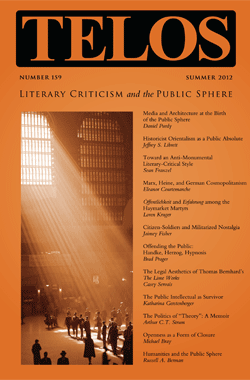Sean Franzel’s article “Toward an Anti-Monumental Literary-Critical Style: Notes on Walter Benjamin and Jean Paul” appears in Telos 159 (Summer 2012). Read the full version online at the Telos Online website or purchase a print copy of the issue here.

Wes Tirey: Can you tell us about how your article explores the question of the “public sphere”?
Sean Franzel: My article explores the question of the public sphere rather indirectly, mainly via the assumption that the project of literary criticism involves the critic positioning him or herself vis-à-vis other critical voices. Criticism seems unavoidably to imply the existence of a/plural community/ies of discourse that debate the status of certain shared objects or topics of interest. My article focuses on two specific critics who take issue with modes of canonical or hegemonic critical discourse that heroize literary and philosophical figures and that cast them as larger-than-life personalities. In its modern form, these discourses begin in the Romantic period, and their legacies reach into twentieth-century authoritarianism as well as into contemporary celebrity culture. My article is interested in different ways that critics resist this heroizing, monumentalizing discourse. Additionally, I suppose that my article presumes the idea that the notion of the “public sphere” references a place where individuals take on certain public personae; in this context, I view figures such as Jean Paul and Walter Benjamin as seeking to counteract the fetishization of larger-than-life heroic public personalities.
Tirey: Your article treats the “public sphere” in Europe [this is true for most in the issue] in a past historical period. What are your views on the status of the public sphere today in the United States? Is the “public sphere” still a useful category?
Franzel: I think concepts of the public and publicity are still very useful; however, I am partial to Michael Warner’s suggestion that we speak of “publics” and “counterpublics” rather than a single “public sphere.” Forms of public speech and public action are inherently intertwined with the communications media we use, and it seems pretty clear that the media landscape of the electronic age has brought even more fragmentation of communities of discourse than previous historical periods dependent on print or electronic broadcast media. Recently, we have seen prominent American journalists at the end of their careers lament the fragmentation of what they describe as the more homogenous public sphere of the past. On the one hand, there is something to this lament: the idea that electronic media have led to left- and right-wing echo chambers where people only ever get news that confirms their own political views, etc. On the other hand, the idea of a single, unified realm of public debate has always been a fiction, an imagined community rather than an empirical object. We need to continue to theorize how different communities of discourse are constituted, and I think theories of the public sphere offer us important tools to do this, as do other frameworks, such as media studies. I also think that theories of the public sphere (going back to Habermas as well as back into the eighteenth and nineteenth centuries) remain relevant insofar as they track shifting configurations of “public” and “private.” Notions of public/private continue to be at the heart of our political debates, and we need to be informed about the history of these ideas. This is an important part of my own research on the history of scholarly culture and the university. In the contemporary university landscape both in the US and Europe, questions as to the role of “public” and “private” forces, institutions, actors, etc. are at the heart of our debates about the future of higher education and its broader social function. The same centrality of notions of privacy and public communication, public self-presentation, and public access in theorizing new electronic media landscapes likewise stands out.
Tirey: I’m intrigued by the idea of having “publics” rather than a “public sphere.” It seems like different variants would foster the dissensus that’s necessary for a robust, engaged social body. Do you think, though, that such “publics” could turn into greater “echo chambers” as you mentioned?
Franzel: I guess one way to approach this question would be to ask what, if anything, ties individual publics back into a larger sense of being part of a social and political collective. To take the example of political discourse in our country today, is there enough shared vocabulary about American political and social belonging across different dissenting communities of discourse? One would want to hope so, but often it seems like the terms of debate are so different—the “freedom” of the tea party is so different from a progressive notion of freedom, for example. Of course, certain publics need not share any vocabulary—one would hardly want to claim that the newsletter of the association of stamp collectors needs to have any common vocabulary with Jay-Z’s Twitter feed—but when it comes to the political realm, the contemporary polarization of communities of discourse seems more often to go hand-in-hand with disinformation and distrust than with a more engaged populace.



